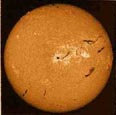
| Bad Astronomy |
|
|
|
BA Blog
|
|
Q & BA
|
|
Bulletin Board
|
| Media |
|
|
|
Bitesize Astronomy
|
|
Bad Astro Store
|
|
Mad Science
|
|
Fun Stuff
|
| Site Info |
|
|
|
Links
|
| RELATED SITES |
| - Universe Today |
| - APOD |
| - The Nine Planets |
| - Mystery Investigators |
| - Slacker Astronomy |
| - Skepticality |
Buy My Stuff

Keep Bad Astronomy close to your heart, and help make me
filthy rich. Hey, it's either this or one of those really
irritating PayPal donation buttons here.
The Long Climb from the Sun's Core
Week of July 21, 1997It has been said that our Solar System really consists of only three things: the Sun, Jupiter, and assorted rubble. With that in mind, we'll start our snacking tour of the Solar System with the part of it that gives it its name: the Sun.
 You may have noticed that the Sun has two overwhelmingly obvious
characteristics: it's bright, and it's hot. These two things are
related. The source of the Sun's heat wasn't understood until
the middle of the 20th century, when nuclear fusion
was first being mathematically analyzed. Although even today we
do not completely understand what is happening inside the Sun, we
have a pretty good grasp of it. Basically, the nuclei of hydrogen
atoms are compressed together so hard that they fuse to form
helium atoms (the actual process is quite a bit more complicated,
but fusion to helium is the end result). This releases a tiny bit
of energy. At least, tiny when you only do it once. But the Sun
converts millions of tons of hydrogen into helium in its core
every second, and so a lot of energy is released.
This energy is in the form of photons, or light.
You may have noticed that the Sun has two overwhelmingly obvious
characteristics: it's bright, and it's hot. These two things are
related. The source of the Sun's heat wasn't understood until
the middle of the 20th century, when nuclear fusion
was first being mathematically analyzed. Although even today we
do not completely understand what is happening inside the Sun, we
have a pretty good grasp of it. Basically, the nuclei of hydrogen
atoms are compressed together so hard that they fuse to form
helium atoms (the actual process is quite a bit more complicated,
but fusion to helium is the end result). This releases a tiny bit
of energy. At least, tiny when you only do it once. But the Sun
converts millions of tons of hydrogen into helium in its core
every second, and so a lot of energy is released.
This energy is in the form of photons, or light.
 These photons have to work their way out from the core of the Sun
to the surface. That's a distance of 700,000 kilometers, or
almost twice the distance from the Earth to the Moon, so you
might expect it takes a while. You might not expect just how
long it does take. The center of the Sun
is extremely dense, and a photon can only travel a tiny distance
before running into another hydrogen nucleus. It gets absorbed
by that nucleus and the re-emitted in a random direction. If that
direction is back towards the center of the Sun, the photon has lost
ground! It will get re-absorbed, and then re-emitted, over and over,
trillions of times. The path it follows is called a "random walk" (or
sometimes a "drunkard's walk"). Eventually it does make its way to the
surface, but it takes a long time: the average photon may bounce
around inside the Sun for 40,000 years!* So the
light you see from the Sun is really very old. The photons were first
emitted long before our civilization began!
These photons have to work their way out from the core of the Sun
to the surface. That's a distance of 700,000 kilometers, or
almost twice the distance from the Earth to the Moon, so you
might expect it takes a while. You might not expect just how
long it does take. The center of the Sun
is extremely dense, and a photon can only travel a tiny distance
before running into another hydrogen nucleus. It gets absorbed
by that nucleus and the re-emitted in a random direction. If that
direction is back towards the center of the Sun, the photon has lost
ground! It will get re-absorbed, and then re-emitted, over and over,
trillions of times. The path it follows is called a "random walk" (or
sometimes a "drunkard's walk"). Eventually it does make its way to the
surface, but it takes a long time: the average photon may bounce
around inside the Sun for 40,000 years!* So the
light you see from the Sun is really very old. The photons were first
emitted long before our civilization began!
* In this Snack, I originally said it takes a million years for a photon to get out. Since then, I have found more recent papers that show that it takes far less, perhaps even as little as 17,000 years. 40,000 is a number that seems to me to be the best supported, but who knows? Maybe future papers will refine the time even more.
Would you like to know more about the Sun? Bill Arnett's "The Nine Planets" page is the definitive guide to our Solar System.
|
|
| THE PANTRY: ARCHIVE OF BITESIZE SNACKS |
|
|
| Subscribe to the Bad Astronomy Newsletter! |
| Talk about Bad Astronomy on the BA Bulletin Board! |